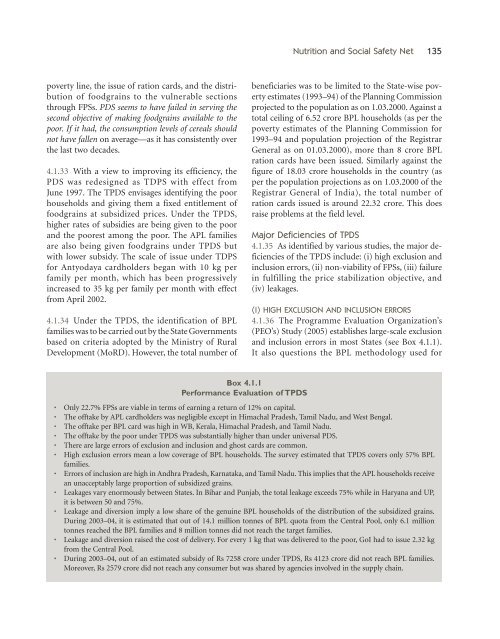Eleventh Five Year Plan
Eleventh Five Year Plan
Eleventh Five Year Plan
Create successful ePaper yourself
Turn your PDF publications into a flip-book with our unique Google optimized e-Paper software.
Nutrition and Social Safety Net 135poverty line, the issue of ration cards, and the distributionof foodgrains to the vulnerable sectionsthrough FPSs. PDS seems to have failed in serving thesecond objective of making foodgrains available to thepoor. If it had, the consumption levels of cereals shouldnot have fallen on average—as it has consistently overthe last two decades.4.1.33 With a view to improving its efficiency, thePDS was redesigned as TDPS with effect fromJune 1997. The TPDS envisages identifying the poorhouseholds and giving them a fixed entitlement offoodgrains at subsidized prices. Under the TPDS,higher rates of subsidies are being given to the poorand the poorest among the poor. The APL familiesare also being given foodgrains under TPDS butwith lower subsidy. The scale of issue under TDPSfor Antyodaya cardholders began with 10 kg perfamily per month, which has been progressivelyincreased to 35 kg per family per month with effectfrom April 2002.4.1.34 Under the TPDS, the identification of BPLfamilies was to be carried out by the State Governmentsbased on criteria adopted by the Ministry of RuralDevelopment (MoRD). However, the total number ofbeneficiaries was to be limited to the State-wise povertyestimates (1993–94) of the <strong>Plan</strong>ning Commissionprojected to the population as on 1.03.2000. Against atotal ceiling of 6.52 crore BPL households (as per thepoverty estimates of the <strong>Plan</strong>ning Commission for1993–94 and population projection of the RegistrarGeneral as on 01.03.2000), more than 8 crore BPLration cards have been issued. Similarly against thefigure of 18.03 crore households in the country (asper the population projections as on 1.03.2000 of theRegistrar General of India), the total number ofration cards issued is around 22.32 crore. This doesraise problems at the field level.Major Deficiencies of TPDS4.1.35 As identified by various studies, the major deficienciesof the TPDS include: (i) high exclusion andinclusion errors, (ii) non-viability of FPSs, (iii) failurein fulfilling the price stabilization objective, and(iv) leakages.(I) HIGH EXCLUSION AND INCLUSION ERRORS4.1.36 The Programme Evaluation Organization’s(PEO’s) Study (2005) establishes large-scale exclusionand inclusion errors in most States (see Box 4.1.1).It also questions the BPL methodology used forBox 4.1.1Performance Evaluation of TPDS• Only 22.7% FPSs are viable in terms of earning a return of 12% on capital.• The offtake by APL cardholders was negligible except in Himachal Pradesh, Tamil Nadu, and West Bengal.• The offtake per BPL card was high in WB, Kerala, Himachal Pradesh, and Tamil Nadu.• The offtake by the poor under TPDS was substantially higher than under universal PDS.• There are large errors of exclusion and inclusion and ghost cards are common.• High exclusion errors mean a low coverage of BPL households. The survey estimated that TPDS covers only 57% BPLfamilies.• Errors of inclusion are high in Andhra Pradesh, Karnataka, and Tamil Nadu. This implies that the APL households receivean unacceptably large proportion of subsidized grains.• Leakages vary enormously between States. In Bihar and Punjab, the total leakage exceeds 75% while in Haryana and UP,it is between 50 and 75%.• Leakage and diversion imply a low share of the genuine BPL households of the distribution of the subsidized grains.During 2003–04, it is estimated that out of 14.1 million tonnes of BPL quota from the Central Pool, only 6.1 milliontonnes reached the BPL families and 8 million tonnes did not reach the target families.• Leakage and diversion raised the cost of delivery. For every 1 kg that was delivered to the poor, GoI had to issue 2.32 kgfrom the Central Pool.• During 2003–04, out of an estimated subsidy of Rs 7258 crore under TPDS, Rs 4123 crore did not reach BPL families.Moreover, Rs 2579 crore did not reach any consumer but was shared by agencies involved in the supply chain.












![[Tam] Uygula[ya] - Bilim, Teknoloji ve Ä°novasyon Politikaları TartıÅma ...](https://img.yumpu.com/36820041/1/184x260/tam-uygulaya-bilim-teknoloji-ve-anovasyon-politikalara-tartaama-.jpg?quality=85)



